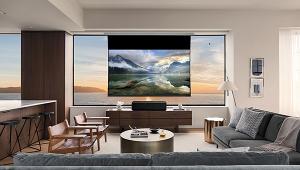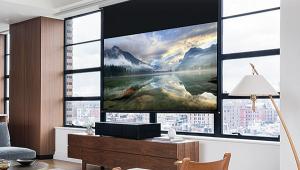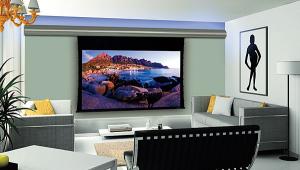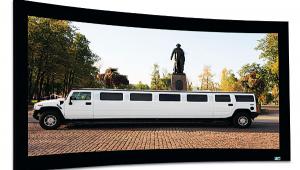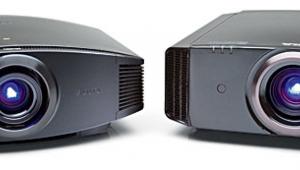Choosing a Front Projector
But the choices abound, and the marketing hype is fierce. We've given you a PRIMER on the essential technologies involved, here are some tips to guide you through quagmire of shopping at retail.
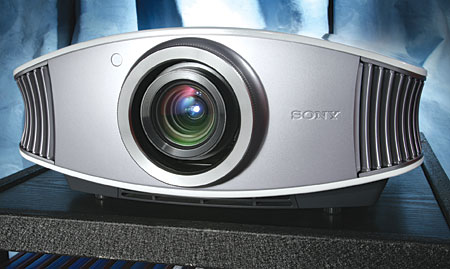
Business PJ vs. Home PJ?
When looking for bargains, many enthusiasts mistakenly include business projectors on their short lists of models to consider. Business projectors can be cheaper, and are often brighter since they're designed for well-lit conference rooms. But they are compromised in ways that usually make them poor choices for home theater use. They will rarely have great black levels, can be noisy, frequently lack full high-definition resolution, and often use native 4:3 imaging panels. They don't always come with optimal connectivity for home theater apps. With the prices of projectors designed for home theater use now at record lows, there's little reason to make such compromises.
1080p or Not 1080p?
Projectors designed for home theater use and high-definition resolution come in two main flavors: 720p and 1080p. While there are still a few 720p projectors at the higher end of the market (particularly of the DLP variety), if you spend more than $3K these days you're likely to be getting a 1080p projector. So it's no longer a question of spending exorbitantly more to get the extra pixels. And on big front projection screens the extra pixels matter—all the more so since we now have high quality 1080p packaged media from Blu-ray and HD DVD.
Does this mean that if you're shopping in sub-$3K 720p market that you're on the outside of high-def looking in? Hardly. You will still see a clear difference between your standard def past and the high-def now. We can't lie to you and tell you that it's 1080p, especially when Blu-ray and HD DVD are on the menu, but there is simply crazy value in the sub-$3K 720p market. The kind of performance you see there now used to cost $10K just a couple of years back.
The Features That Matter
Lens shift: This is old school, but it still matters. It used to be important to have the lens of your PJ aligned very precisely with the screen it's firing upon. In digital displays the electronic methods of correcting for any offset (such as digital keystone correction) in your install degrade image quality. Getting a PJ with vertical lens shift gets the job done without inducing artifacts, and a wide variety of displays are now offering this feature. Some projectors even offer horizontal lens shift. It's less of a must-have than vertical, but still useful.
Connections: HDMI connections are ubiquitous on new displays. You defintely want and need HDMI. Not only is an all-digital connection to the display desirable, HDMI scratches Hollywood's copy restriction itch. Don't forget that Blu-ray and HD DVD were forced by Hollywood to carry the ability to downconvert the component video outputs on players. We haven't been pinched by this "Image Constraint Token" yet, but HDMI means you don't have to worry.

The latest rage are displays that offer HDMI spec 1.3. On the video side, what HDMI 1.3 offers over its predecessors is compatibility with Deep Color and x.v.Color. But for either to provide any benefit the source must also be compatible with these new standards. At present, there are no sources we're aware of that conform to Deep Color specs, and x.v.Color is available only in a few camcorders. These video features of HDMI 1.3 might be valuable in the future when we get sources, but they're borderline vaporware as of now.
HDMI gets a bum rap, and often deserves it. But HDMI is likely to remain the connection du jour for some time. The HDMI spec is now so far above and beyond what our software is capable of delivering that it will be a long time before we bunp up against its performance ceiling. Get as many HDMI inputs as you can.
Dynamic or Auto Iris: This is the real deal. At its root level a dynamic iris opens and closes a physcal iris depending on the brightness levels in the image. As the image gets darker the iris closes down, and as the image gets brighter it opens up. But it's even more complex than that. Lots of electronic processing accompanies this process, and it's tricky to make it work invisibly, but a number of manufacturers have managed this feat.
Smart implementations of this feature have brought state-of-the-art performance with blacks and contrast to surprisingly affordable price points and performed miracles in bringing LCD/LCoS displays neck and neck with the very best DLPs in these critical regards. This feature has been so successful in these designs that we are starting to see DLPs follow suit.
When evaluating a display's dynamic iris to ensure it's operation is undetectable, find a scene that cuts back and forth between light and dark images. BLANK scene in Pirates of the Caribbean: Dead Man's Chest is a perfect example. Watch this scene and see if you notice the dynamic iris opening and closing to a distracting degree.
Premium processing solutions: This is a key area in which manufacturers attempt to distinguish their products, and is meaningful, especially in displays (although premium processing is now appearing regularly in source components, AVRs and pre/pros).
The image quality of a display depends heavily on the quality of the video processing used. Standard-def signals need to be processed to match the resolution of the display, and while 1080p sources might eliminate the need for deinterlacing, both 480i form DVD and even 1080i HD from broadcast depend on precise deinterlacing for both film and video-based sources.
Although Faroudja is still in the game, the biggest names in this arena today are Gennum and Silicon Optix. A number of products we've seen with both solutions offer superb video processing that enhances the performance of the video system as a whole.
1080p input capability: Many displays cannot properly deinterlace a 1080i film-based source. But with the advent of HD DVD and Blu-ray, true 1080p sources are upon us. If the display will accept 1080p directly, it will not have to deinterlace such a source.
1080p/60 is the most prevalent form of 1080p in sources and displays. But the number of high-definition players that can output at 1080p/24 is growing. You want 1080p/60 input capability in your PJ for sure, and if you can get it, 1080p/24 is even better. At least a little bit.
Movies are shot at 24 frames-per-second (fps). A process called 3/2 pulldown is used to convert 24fps sources to 30Hz or 60Hz for compatibility with the displays of the past, which have typically operated at either 30Hz or 60Hz.
Blu-ray and HD DVD movies are encoded at 1080p/24. Displays that can accept 1080p/24 and display it at a refresh rate (akin to frame rate) that's a direct multiple of 24- such as 48Hz or 72Hz- avoid 3/2 pulldown entirely. There is no deinterlacing involved and the time distortion, called "judder," that's required to display a 1080p/24 source at 30Hz or 60Hz is eliminated. This results in smoother motion and a more film-like image. It's generally a subtle improvement, but an improvement nonetheless. Get it if you can.
Throw distance: You'll want to insure that the zoom range of the projector's lens will provide the size image you require at a projector-to-screen distance that you can accommodate in your room. For example, if you have to position the projector 16-feet from the screen to get that 7-foot wide image, but your room is only 15 feet deep, you'll need either a smaller screen or a different projector.
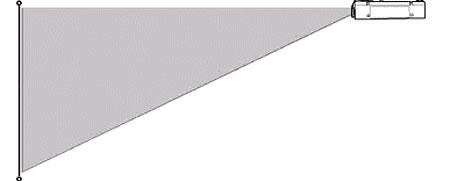
The only way to determine this ahead of time is to check with the manufacturer or your dealer. Such information is also often provided in tables in the owner's manual, and many manufacturers now offer these manuals on line. Just be certain when you use such tables that it's clear how the screen size is specified—by diagonal or width—and that the table is for a 16:9 screen. Make sure you can tell whether the distance shown is to the front of the lens or the back of the projector, and be sure to allow enough clearance for the connections. It's always a good idea to allow a couple of feet of leeway to avoid unpleasant surprises. That is, if your room offers a maximum depth of 16-feet, don't plan on positioning the projector more than 14-feet back.
Specifications: While many of the characteristics you see addressed in a projector's specifications are important, be wary of using them to compare one projector to another. For example, many manufacturers have creative ways of measuring contrast ratio and light output to get the most impressive numbers. But the methods vary from one manufacturer to another, so the numbers are not comparable. This isn't much use if you want a projector with (everything else being equal) the highest light output together with the deepest blacks. The best way to sort this out is from reviews performed by publications that provide both subjective comments and useful measurements.
